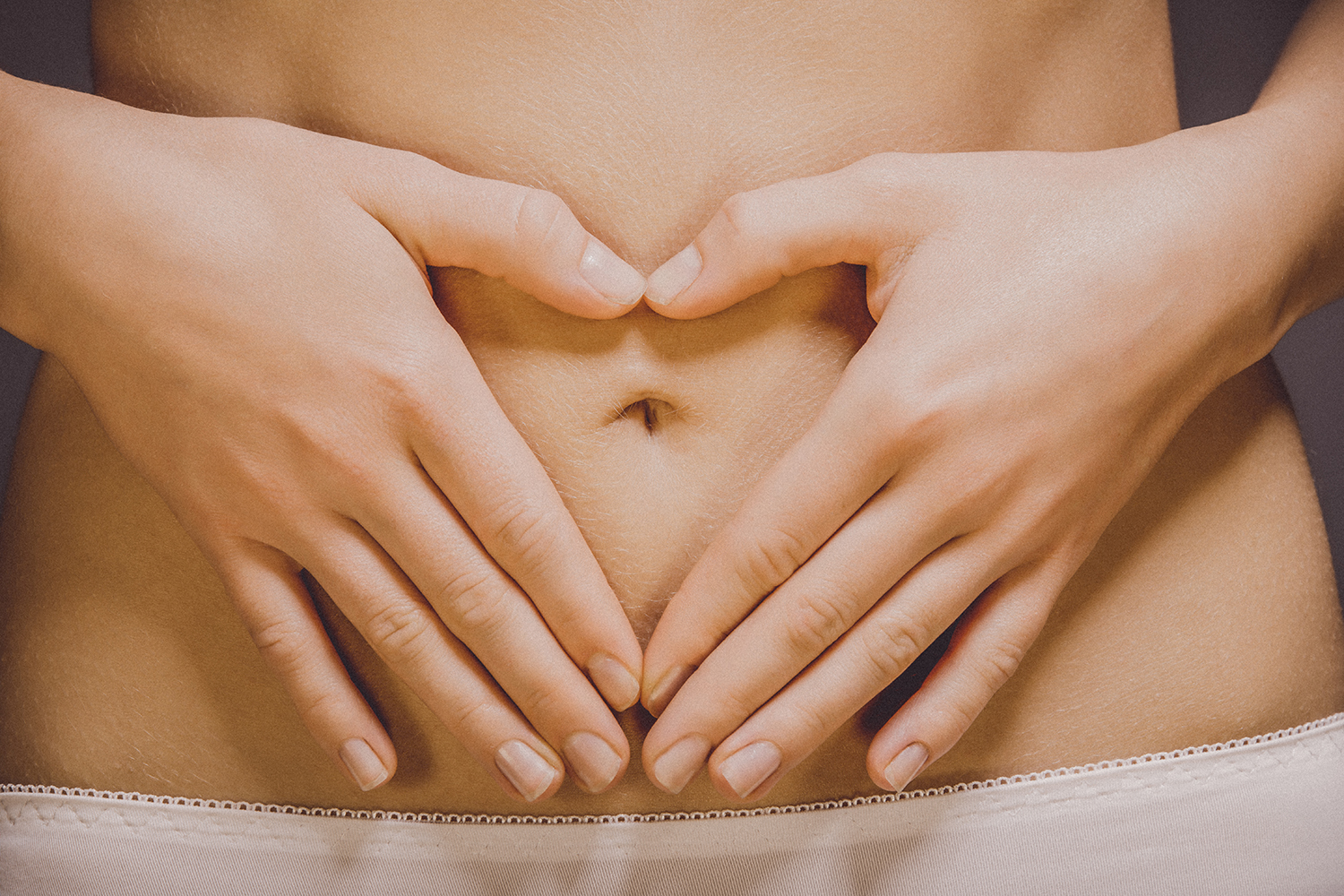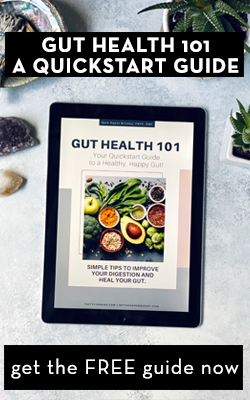
Restore Your Gut Health with the Four Rs of Gut Healing
Our health begins in the gut! It is estimated that as much as 80% of our immune system is located in our gut and that over 90% of the chemicals responsible for regulating moods, neurotransmitters such as serotonin and dopamine, are made in our gut. Not only is it important to be sure our digestion is functioning properly so we can feel our very best, but healthy digestive function is also crucial to being able to absorb, assimilate and use the nutrients we consume daily in our healthy, whole foods diet.
If you are suffering from digestive discomfort like bloating and gas, stomach aches, indigestion or acid reflux, nausea, chronic diarrhea or constipation – I can assume you are well aware that those are symptoms of an imbalanced gut. But, did you know that seasonal allergies, sinus congestion, a compromised immune system (and yes, autoimmune disease), fatigue, mood imbalances, hormone imbalances, bad breath, weight gain, acne, metabolic dysfunction – these too can all be signs of gut dysbiosis.
Gut impermeability, gut inflammation and other digestive dysfunction symptoms may be displayed in your gut but their effects are systemic and can affect the whole body. The gut is the core of our health and it is essential to have a healthy gut in order to have a healthy body. Gut dysbiosis can be caused by a myriad of things, from chronic antibiotic use, an unhealthy, imbalanced diet that lacks nutrients or contains harmful substances, alcohol abuse, illness, chronic high stress levels, medications and other lifestyle issues.
The Gut Brain Connection
The gut is often referred to as the enteric nervous system (ENS) or the intrinsic nervous system, as it is of the main divisions of the autonomic nervous system (ANS) and consists of a mesh-like system of over 500 neurons that governs the function of the gastrointestinal tract. This is why you will hear people call the gut, the second brain of the body, but the enteric nervous system normally communicates with the central nervous system (CNS) through the parasympathetic (via the vagus nerve ) and sympathetic (via the prevertebral ganglia) nervous systems and it can still function when the vagus nerve is severed. The ENS is responsible for controlling digestion, equipped with its own reflexes and senses it controls gut behavior independently of the brain. These functions include breaking down food, absorbing nutrients, and expelling of waste requires chemical processing, mechanical mixing and rhythmic muscle contractions that move everything on down the line.
90 percent of the fibers in the primary visceral nerve, the vagus, carry information from the gut to the brain and not the other way around. This is why it’s believed that a large part of our emotions are influenced by the nerves in our gut. Although gastrointestinal (GI) turmoil can definitely affect and sour one’s moods, everyday emotional well-being may rely on messages from the brain below in the gut to the brain above.
The second brain of the enteric nervous system is the reason we get butterflies in our stomach or need to use the restroom more frequently when we are nervous and/or under stress.
The enteric nervous system also makes use of more than 30 neurotransmitters, most of which are identical to the ones found in the CNS, such as acetylcholine, dopamine, and serotonin. More than 90% of the body’s serotonin is in the gut, as well as about 50% of the body’s dopamine, which is currently being studied to further our understanding of its utility in the brain.
We often talk about a “gut feeling” when we meet someone for the very first time. We’re told to “trust our gut instinct” when making tough decisions or we have “gut check” moments when faced with situations that may test our nerves and determination. The mind-gut connection is not just metaphorical. Our brain and gut are connected by the extensive network of neurons and a highway of chemicals and hormones that constantly provide feedback about how hungry we are, whether or not we’re experiencing stress, or if we’ve ingested a disease-causing microbe. This information superhighway is called the brain-gut axis and it provides constant updates on the state of affairs at your two ends. That sinking feeling in the pit of your stomach after you get some very bad news is a vivid example of the brain-gut connection at work. You are stressed and your gut knows it—immediately.
We could go on and on about the gut brain connection, as well as hypothalamic-pituitary-adrenal axis, or HPA axis, another mechanism by which the brain can communicate with the gut to help control digestion through the action of hormones but honestly, that’s deserving of it’s own post altogether. The purpose of sharing all this is to really drive home the complexity of our gut and more specifically help you to understand how crucial the gut is to our overall physical health along with the state of our brain and our moods – this is why gut healing is imperative. Mostly, I want to teach you and empower you to manage, support and heal your microbiome and your gut because – a happy gut is a happy life!!
Gut Healing
Healing your gut can often feel incredibly complicated and overwhelming, I know, because I have absolutely been there – but it doesn’t have to be. Below is a simplified version of the gut healing approach I take my clients through. The Four Rs are a classic gut healing approach in functional medicine and while working one-on-one with a practitioner or a nutritionist allows you a more customized protocol and possibly testing – I want to share just how simple this foundational protocol can be, so you can get started right away getting that gut right!
The Four Rs of Gut Healing.
1) Remove (Reduce and Reset)
The goal here is to reduce intestinal inflammation and remove any foods that can be feeding unwanted pathogenic yeast, bacteria or parasites to avoid overgrowth. We want to take away the biggest culprits, first until the gut is healed. This can be pro-inflammatory foods and chemical irritants that can trigger irritation and create an environment for bacteria, parasites and candida to thrive. High carbohydrate and sugar containing foods or those with added yeast have been shown to feed bad bacteria and cause yeast overgrowth in the small intestine. Foods like gluten (and other grains), corn, dairy, sugar, alcohol and coffee, vegetable oils, artificial sweeteners and processed foods can drive inflammation in the gut and the body. We want to give the GI tract an opportunity to be soothed and allow the immune system to be less burdened by irritating and inflammatory compounds.
It should also be said that these first Rs definitely go beyond food stressors. When it comes to the health of our gut it’s also very important to remove other non-food, chronic stressors that may be driving inflammation, so this is a great time to look at your lifestyle and to also reduce your exposure to toxins in your environment (and your thoughts) and prioritize sleep – removing these triggers can help to give your gut an opportunity to reset. Depending on the severity of your gut dysbiosis this stage of removal may also pertain to the removal of foreign pathogens in the gut, like parasites, bacteria or yeast. If you suspect your dysbiosis is beyond foods and other stressors, a comprehensive stool analysis can be key to determining if further action is necessary with herbal antimicrobials or antibiotics, etc.
2) Replace
Eat a diet rich in a diverse range of nutrient-dense whole foods. This can lead to a diverse microbiota, which is beneficial for your health. I also suggest that you incorporate foods to further support your digestion, like apple cider vinegar and water, lemon water, or bitter greens. You can also work with a practitioner to incorporate quality supplements that can support hydrochloric acid and digestive enzyme production, these can work alongside your healthy diet to encourage a proper functioning digestive system. When we use food as medicine this can benefit the microbiota by enhancing its function and reducing the abundance of disease-causing bacteria in the intestines.
3) Repair
Building on the idea of replacing, we want to be sure we are consuming food and supplements that support and repair proper digestion. Through healing the gut lining it also supports the absorption of nutrients in the foods you are eating. You may want to consider additional gut repair support like collagen and gelatin-rich bone broth, L-glutamine, aloe, curcuminoids from turmeric, bromelain or slippery elm. It’s also just as simple as making sure you are getting enough water, every day and consuming quality omega-3 fatty acids each week, which will help with overall inflammation in the body. Consider breath exercises, gentle movement, meditation and other stress reducing practices and be sure to get adequate sleep to further repair the gut by reducing inflammation.
4) Reinoculate (and Rebuild)
Finally, it can be helpful to reintroduce good bacteria to your gut environment in an effort to populate your GI tract with as much of the beneficial stuff as possible. Now that you have eliminated the problem foods and spent time repairing the gut, it’s time to bring in the big guns! Fermented veggies like sauerkraut, kimchi, beet kvass, pickles, coconut kefir, non-dairy yogurt are all great food sources of broad strains of probiotics. Foods, while each can uniquely contain different strains than the next, they can be limiting with only a couple different strains each and many of the strains in probiotic foods are not always acid resistant (ie they die off in big numbers when hitting the acidic stomach), as well some people can not tolerate fermented foods – this is when a probiotic supplement is great.
When you are looking at a probiotic supplement, the CFUs or colony forming units represent the number of active probiotics that the product offers. You want to look for daily maintenance doses between 5 and 20 billion, and more if you need acute support (after antibiotics, etc.) By looking at your digestive health goals you can find the stain count that is right for you. More isn’t always better. What does your microbiome currently need? A lower CFU count of 5-20 billion are great for an already healthy gut just looking for daily maintenance. 50 billion CFUs would be optimal for after travel or in times or stress. 200 billion would be intense support for flora balance when your intestinal health needs it mos, possibly after traveling abroad or after a round of antibiotics. To learn more about probiotics and their benefits, check out this post to select the correct probiotics for you and which brand I recommend to my clients.
I believe that the Four R approach can help you feel empowered to take control of your health and heal your gut. Working with my nutritional therapy clients, I have seen dramatic reductions in symptoms and reversal of chronic illnesses in short periods of time by utilizing this simple approach.
If you take yourself through these Four Rs and you are still having issues or symptoms, it is possible you may need additional, more in-depth testing or a more specific custom-tailored treatment plan.
If you want to better understand how digestion *should* work and where dysfunction can arise plus how to remedy it, check out my 5-Part Digestion 101 Series.
Lastly, if you want to learn more about gut healing, check out the 2-part gut healing series I hosted LIVE in our Facebook Community The Tasty Yummies Taste Buds – click that link to request access to the group.
You can also read about how I manage a gut flare up and a few more of my gut-healing go-tos.










